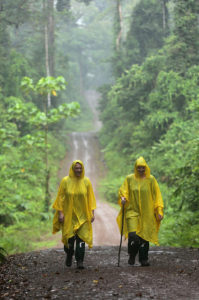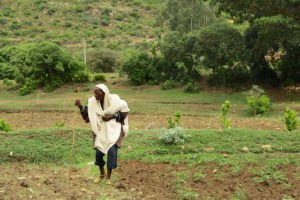
By Vincent Gitz, Director, CGIAR Research Program on Forests, Trees and Agroforestry, and Meine van Noordwijk, Landscape Research Leader, CGIAR Research Program on Forests, Trees and Agroforestry.
FTA recently organized a two-day virtual symposium entitled Trees, forests and water: cool insights for a hot world to share live online the findings of a recent review paper by David Ellison and 21 other scientists, including four from FTA, and discuss their implications for research and policy.
The findings shed brand new light on the role of forests and trees in the climate debate.
Also read: Cool insights for a hot world
Since Rio 1992 and the climate convention, climate policy has put a “mitigation” sticker – with the associated pressure – on forests and land use for their role in climate, emphasizing the carbon stored in forests and peat soil, and the capacity of trees to sequester carbon.
This triggered a lot of scientific work and publications, including by FTA scientists, on the best pathways to strengthen the role of forests and trees in climate mitigation. Attention was given to integration with other dimensions (‘cobenefits’ and ‘safeguards’) beyond carbon measures, especially social and economic dimensions.
It also triggered many debates, in science and in policy, as to whether or not this was the right approach, such as the recurrent debates about land-use and forestry-related loopholes in the necessary climate action in the energy sector.

However, this perspective on forests and climate change might well change radically. And the change may not come from carbon, but from water.
What is this new light? The findings of the review, with the level of confidence of underlying scientific evidence – assessed in the symposium – are the following:
- Trees influence local temperature through high transpiration rates, and remote sensing and infrared tools exist for visualizing this effect (very high confidence).
- Forests recharge atmospheric moisture and regional evapotranspiration responds to tree-cover transitions (very high confidence).
- Vegetation and trees influence cloud formation and trigger rainfall via bioprecipitation effects (high confidence).
- Historical evidence from tree rings and their isotopic composition shows decadal variation and local influences of land use on local rainfall and climate (medium confidence).
- Rainbow (atmospheric) water bookkeeping combined with prevailing winds shows continental-scale teleconnections on all tropical continents. Forests enable cascading transport of water vapor over distant locations, and therefore rain, far from the sea (high confidence).
- Forests, as biotic pumps, attract air and moisture flows, and the loss of forests can create a tipping point turning wet climates to dry climates (medium confidence).
- Trees and forests can improve groundwater recharge, with the existence of an optimum level of tree cover for that effect (high confidence).

To sum up: forests and trees are drivers of key mechanisms that govern the water cycle, atmospheric moisture, precipitation and climate at the local, regional and continental levels. In other words, forests and trees can help manage the water cycle not only from the well-known watershed perspective, but from a precipitation-shed perspective, with key implications for climate regulation. Geopolitical implications are huge: Who has the right to influence rainfall elsewhere? Yet, that happens every day, according to the new hydroclimate paradigms.
So what?
Altogether, these findings have significant implications for policy and action, and for research – particularly for FTA research – and what it can do or the tools it can provide to inform and underpin this new agenda.
Climate research
The first implication is for climate research itself, to better understand “where does rain come from?” with a priority challenge of better incorporating the above processes in general circulation models. This would inter alia lead to the improvement of the projection of precipitation and its variability, and to a better estimation of the magnitude of the effects by which forests – and land use – contribute to the processes that determine winds and rain in different regions. We need to better quantify the extent of relevant hydroclimatic relations between trees, forests and climate.

Climate policy
In climate policy, it calls for a threefold change of narrative:
- Carbon sequestration and mitigation, rather than being the main focus, are to be seen as cobenefits of climate action in landscapes.
- Adaptation of forests is important, but even more important is the role that forests and trees will play for the adaptation of agriculture, food security, water security and livelihoods, as well as to avoid ecosystems experiencing tipping points.
- The top-down policy perspective on forests (their role in the global carbon cycle, absorbing the world’s excess CO2) is shifting to a bottom-up policy perspective (their role in the water cycle and in localized climates).
This triple change of narrative calls for research to look into integrated approaches to revisit the currently segregated mitigation-versus-adaptation frameworks (including related procedures and funding), especially from the perspective of the implementation of the NDCs, many of which include a range of targets for sustainable forest management, including afforestation, reforestation and forest restoration.
It will further interrogate REDD+ and call for research to help establishing measurable metrics to quantify the role of forests with regard to adaptation benefits on different scales, from local and national to regional and continental. More broadly, it will call on research to assist in the refinement of existing and new climate change policy frameworks, building on the adaptation article (Article 7) of the Paris Agreement, in order to ensure synergies with and within the SDGs.

Importantly, it will also put back the mitigation focus on fossil fuels and the energy sector, contributing to ending the often counterproductive land carbon “loophole” debate, while at the same time giving even more emphasis to the roles of land use, forests and trees for climate regulation.
Land restoration
These findings can help better understand – or avoid mistakes on – what to plant where and how or what natural regeneration to assist. They provide a hydroclimatic rationale over and above the current carbo-climate metrics of performance for tree-based landscape restoration.
They call for research to provide more information on plant functional attributes (as a source of nucleating particles for biological generation of rainfall) across climates and ecozones. They also call for research to provide tools that include a hydroclimatic perspective for stakeholders to better assess the costs and benefits of action including not only downstream benefits, but also those beyond the watershed, downwind, complemented by economic and social analysis.
Integrated landscape policies
Here the question is how to organize land use on different scales for water and climate. More effective, tailored information (including maps, transfer functions, remote sensing and visualization tools) on the location-specific nature of atmospheric moisture, rainfall and their sources can lead to improved integrated water, land and climate policies in the forest-rural-urban continuum.

This would lead to water policies going beyond the watersheds, toward “precipitationsheds.” Research should look into what institutional mechanisms and incentive schemes would account for such land/water teleconnections, and remote impacts from where actual land use, tree planting or removal decisions are made.
Food security
This research gives a new perspective on the role of forests and trees from continental to farm scale for food production and food security. Here research should strive for a better understanding of the decadal scale variation in rainfall and its origins (oceanic/terrestrial), to contextualize current climate and yield variability and support landscape-level ‘climate-smart’ options.
It can document and quantify the role of forests that generate rainfall in teleconnected but distant areas (including “bread baskets”). Finally, on a more local scale, it can provide new insights on how to integrate trees and forests in agriculture/crop systems.

Sustainable Development Goals
A last domain relates to the achievement of the SDGs. Expanding our interpretation of the development targets to embrace the concept of a land-food-water-energy-climate-biodiversity nexus on the landscape scale could provide a better point of reference than existing segregated policies. Research should provide operational insights on the use of forests and trees – fully embracing their relationship with water – in achieving and connecting the SDGs. It should aim for actionable, concrete and easy-to-grasp solutions for multiple objectives, and guidance on forests, trees and land-use options are part of them.
It is not often in research that efforts lead to considering possible “changes of theory” and such-wide ranging implications. The next challenge for research is both internal and external: for us to better quantify and assess the magnitude of these relations, providing clarity about uncertainties and validity domains (including on the diversity of local-specific situations), and to avoid oversimplification.
This will enable us to pursue our quest for strengthening the knowledge base, while being credible enough not to delay the opening of new avenues for action, with clarity on current evidence, (un)certainties, and policy and development implications.











